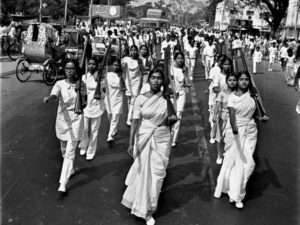Every rejected veil disclosed to the eyes of colonialists horizons
until then forbidden
piece by piece- the flesh of Algeria laid bare
Every veil that fell,
every body that became liberated from the traditional embrace of the haïk–
every face that offered itself to the bold and impatient glance of the occupier–
was a negative expression,
of the fact that Algeria was beginning to deny herself,
and was accepting the rape of the colonizer.
Algerian society– with every abandoned veil,
seemed to express its willingness
and attend to the master’s school,
and to decide to change its habits-
under the occupier’s direction and patronage.
-Algeria Unveiled, “A Dying Colonialism” by Frantz Fanon (42-43)
Reading this passage by Frantz Fanon captured my attention in the way that Fanon details the impact of colonialism on the women in Algeria under France’s rule. The pressures that many Algerian women were faced with between what was their normal ways of dressing and what the native culture accepted, versus what the infiltration of European colonialism deemed restrictive and having tp adapt to the new culture. This passage has added onto my already existing knowledge of what life was like for many African nations under the rule of European powers. And these restrictions expanded beyond the continent as well. Even during the times of slavery and Jim Crow, black women were (and still are) subjected to the European standard of beauty. The way that white women looked and dressed was to be envied and copied.
It’s interesting to see that the pressures of fitting into the societies that white people have crafted, is a dilemma that women of color have been facing for over 400 years now. What was normal for women prior to European contact is now seen as uncultured and barbaric. When white people come into a society and try to change what was already there, it seems that what they bring to a country and its culture is the “right way” to do things. When the European standard of beauty is forced upon women of color, we tend to doubt ourselves and eventually give into the standards. In the case of the Algerian women, the decision to take off the haïk and wear less clothing is like accepting defeat and allowing the colonizer to dictate how women should be allowed to dress. Anything that is traditional is barbaric and “limits” the rights of women.
As Shange says in “Porque tu no m’entrende?”, we must “break through the grids of colonial contrivance and discover who has truly been round and about us, who is round and about us”. This is how I relate both of these examples to my own life. As a curvy black woman with type 4 natural hair living in America, I still face these colonial restraints that stemmed from my great great grandmothers all the way down to me. If one thing has not changed, it’s the fact that we all dealt with the pressures of the European standard of beauty. It causes you to doubt yourself. How will people think of me when my hair is in its natural state? Am I less desirable because I am not on the thinner side of the weight spectrum? Am I not worthy enough because my skin is darker? Should I become something that I am not? These are the questions that I am faced with as I walk through this world. One thing for certain that I have learned from both texts is that the European standard of beauty has always been there, but it is now my job to break the grids of colonial contrivance and love me for who I am.




